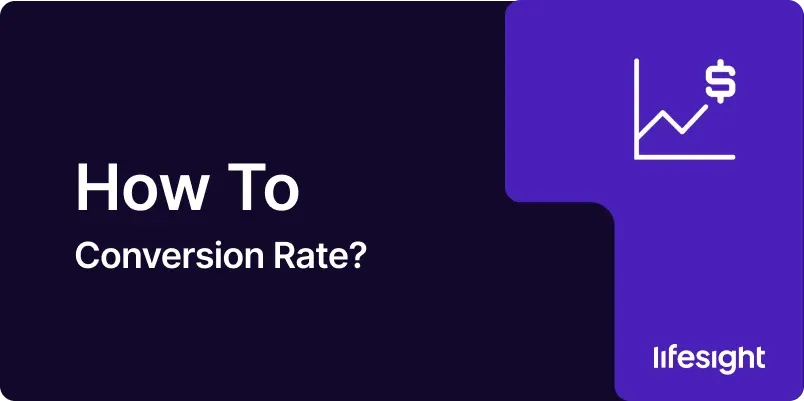
Short Description
Conversion rate is a critical metric that measures the percentage of visitors who complete a desired action on a website or app. It’s essential for evaluating marketing effectiveness and user experience.
Introduction
In the digital world, success is often measured by how effectively you can turn visitors into customers, subscribers, or leads. This is where conversion rate comes into play. Whether you’re running an e-commerce store, a blog, or a SaaS platform, understanding and optimizing your conversion rate is crucial for growth and success. This guide will walk you through everything you need to know about calculating and using conversion rate to improve your digital performance.
Definitions of Key Terms
Before we dive into the calculation of conversion rate, let’s define some key terms:
- Conversion Rate: The percentage of visitors who complete a desired action on a website or app.
- Conversion: The specific action you want users to take, such as making a purchase, signing up for a newsletter, or filling out a contact form.
- Visitor: An individual who comes to your website or app, typically measured as a unique user.
- Session: A group of user interactions with your website that take place within a given time frame.
- Landing Page: The first page a visitor sees when they arrive at your website, often designed specifically to encourage conversions.
- Call to Action (CTA): A prompt on a website that tells the user to take some specified action.
- Funnel: The path a customer takes through your website or app towards conversion.
- Bounce Rate: The percentage of visitors who leave your site after viewing only one page.
- A/B Testing: A method of comparing two versions of a webpage or app against each other to determine which one performs better.
- Micro-conversion: A small action that users take that indicates they are moving towards a macro-conversion (e.g., adding an item to a cart).
The Formula to Calculate Conversion Rate
The basic formula for calculating conversion rate is:
Conversion Rate = (Number of Conversions / Total Number of Visitors) x 100%
It’s important to note that “”visitors”” can sometimes be replaced with “”sessions”” or “”unique visitors,”” depending on your specific needs and tracking capabilities.
Step-by-Step Guide to Calculating Conversion Rate
- Define Your Conversion: Clearly identify what action constitutes a conversion for your specific goal.
- Choose Your Timeframe: Decide on the period over which you want to measure conversions (e.g., daily, weekly, monthly).
- Gather Your Data: Collect the number of conversions and the total number of visitors for your chosen timeframe.
- Apply the Formula: Divide the number of conversions by the total number of visitors.
- Convert to Percentage: Multiply the result by 100 to get your conversion rate as a percentage.
Example Illustrating the Conversion Rate Formula
Let’s walk through a practical example to illustrate how to calculate conversion rate:
Suppose you run an online store, and last month you had:
- 10,000 unique visitors to your website
- 300 completed purchases
Applying the conversion rate formula:
Conversion Rate = (300 / 10,000) x 100% = 3%
This means that 3% of your visitors made a purchase, which is your conversion rate for purchases.
What Conversion Rate is Used For and Why It’s Important
Conversion rate is a crucial metric for several reasons:
- Performance Measurement: It helps you understand how effectively your website or marketing campaigns are achieving their goals.
- Optimization: By tracking conversion rates, you can identify areas for improvement in your website design, user experience, or marketing strategies.
- ROI Calculation: Conversion rates are essential for calculating the return on investment of your marketing efforts.
- Benchmarking: It allows you to compare your performance against industry standards or your own historical data.
- Resource Allocation: Understanding which pages or campaigns have the highest conversion rates can help you allocate resources more effectively.
- User Behavior Insights: Conversion rates can provide insights into user preferences and behavior.
- Goal Setting: It helps in setting realistic targets for future campaigns or website improvements.
Where Conversion Rate Calculation is Applied
Conversion rate calculations are applied across various digital marketing and business contexts:
- E-commerce: Measuring the rate of visitors who make a purchase.
- Lead Generation: Tracking how many visitors fill out contact forms or request information.
- Content Marketing: Measuring sign-ups for newsletters or downloadable content.
- SaaS Platforms: Tracking free trial sign-ups or upgrades to paid plans.
- Advertising Campaigns: Evaluating the effectiveness of ads in driving desired actions.
- Landing Pages: Assessing how well specific pages convert visitors into leads or customers.
- Email Marketing: Measuring click-through rates and subsequent conversions from email campaigns.
- Mobile Apps: Tracking app installations or in-app purchases.
- Brick-and-Mortar Stores: Measuring conversions from digital ads to in-store visits or purchases.
- B2B Marketing: Tracking conversions through complex, multi-step sales funnels.
Limitations of Conversion Rate
While conversion rate is a valuable metric, it has several limitations:
- Doesn’t Measure Quality: A high conversion rate doesn’t necessarily mean high-quality conversions or customers.
- Ignores Customer Journey: It doesn’t account for the multiple touchpoints that may lead to a conversion.
- Can be Misleading in Isolation: A low conversion rate might be offset by high traffic or high average order values.
- Doesn’t Consider Costs: Conversion rate alone doesn’t indicate profitability.
- Variability: Conversion rates can vary widely based on industry, product type, and target audience.
- Doesn’t Reflect Customer Lifetime Value: It focuses on immediate conversions rather than long-term customer value.
- Potential for Manipulation: Focusing too much on conversion rate can lead to manipulative tactics that harm user experience.
- Doesn’t Account for Offline Conversions: For businesses with both online and offline presence, online conversion rates may not tell the full story.
Factors Impacting Conversion Rate
Several factors can significantly impact your conversion rate:
- Website Design and User Experience: A well-designed, user-friendly site typically converts better.
- Page Load Speed: Slow-loading pages often lead to higher bounce rates and lower conversions.
- Mobile Responsiveness: With increasing mobile traffic, a mobile-friendly design is crucial for conversions.
- Copy and Messaging: Clear, compelling copy can significantly improve conversion rates.
- Trust Signals: Elements like security badges, testimonials, and reviews can boost user trust and conversions.
- Call to Action (CTA): The design, placement, and wording of CTAs can greatly affect conversion rates.
- Targeting and Relevance: Attracting the right audience with relevant content and offers is key to high conversion rates.
- Competitive Landscape: Your conversion rate may be influenced by what competitors are offering.
- Seasonality and Timing: Many businesses see fluctuations in conversion rates based on time of year or even time of day.
- Price and Offer: The attractiveness of your pricing and offers directly impacts conversion rates.
Other Strategies for Assessment
While conversion rate is crucial, it should be used alongside other metrics for a comprehensive assessment:
- Average Order Value (AOV): Measures the average amount spent each time a customer places an order.
- Customer Lifetime Value (CLV): Estimates the total revenue a business can expect from a single customer account.
- Return on Ad Spend (ROAS): Measures the revenue generated for every dollar spent on advertising.
- Net Promoter Score (NPS): Measures customer experience and predicts business growth.
- Bounce Rate: Indicates the percentage of visitors who leave your site after viewing only one page.
- Time on Site: Measures how long visitors stay on your website.
- Pages per Session: Tracks how many pages a visitor views in a single session.
- Cart Abandonment Rate: For e-commerce, measures how often shoppers add items to their cart but don’t complete the purchase.
- Customer Acquisition Cost (CAC): Measures the cost of convincing a potential customer to buy a product or service.
- Churn Rate: For subscription-based businesses, measures the rate at which customers stop doing business with you.
The Relationship Between Conversion Rate and Other Metrics
Understanding how conversion rate relates to other metrics provides a more comprehensive view of performance:
- Conversion Rate and Traffic: High traffic with a low conversion rate might indicate targeting or user experience issues. Here some Conversion Rate Optimization Strategies
- Conversion Rate and Bounce Rate: Generally, a high bounce rate correlates with a low conversion rate.
- Conversion Rate and Average Order Value: These two metrics together give a better picture of revenue than either alone.
- Conversion Rate and Customer Lifetime Value: A low conversion rate might be acceptable if it brings in high-value, long-term customers.
- Conversion Rate and Return on Investment (ROI): Conversion rate is a key factor in calculating ROI for many digital marketing efforts.
- Conversion Rate and Cost Per Acquisition (CPA): Improving conversion rate often leads to a lower CPA.
- Conversion Rate and Revenue: While they often correlate, it’s possible to increase revenue without increasing conversion rate (e.g., by increasing traffic or average order value).
Benefits of Calculating Conversion Rate
Regularly calculating and analyzing conversion rate offers numerous benefits:
- Performance Insight: Provides a clear metric for how well your website or campaign is performing.
- Optimization Opportunities: Helps identify areas for improvement in your website or marketing strategies.
- Budget Allocation: Assists in determining which channels or campaigns are most effective, helping with budget decisions.
- Competitive Advantage: Understanding and improving your conversion rate can give you an edge over competitors.
- Improved User Experience: Focusing on conversion rate often leads to improvements in overall user experience.
- Revenue Growth: By improving conversion rate, you can increase revenue without necessarily increasing traffic.
- Cost Efficiency: Higher conversion rates can lead to lower customer acquisition costs.
- Goal Setting: Provides a concrete metric for setting and tracking business goals.
- Testing and Innovation: Encourages ongoing testing and innovation to improve performance.
- Customer Understanding: Analyzing conversion rates for different segments can provide insights into customer preferences and behavior.
Conclusion
Conversion rate is a powerful metric that provides crucial insights into the effectiveness of your website, marketing campaigns, and overall digital strategy. By mastering the calculation and interpretation of conversion rate, businesses can make data-driven decisions to optimize their online presence, improve user experience, and drive growth.
However, it’s important to remember that while conversion rate is valuable, it should not be used in isolation. Combining conversion rate with other performance metrics, considering its limitations, and placing it in the broader context of your business goals will provide a more comprehensive view of your digital performance.
As the digital landscape continues to evolve, so too will the strategies for calculating and optimizing conversion rates. Staying informed about new technologies, user behaviors, and industry benchmarks will be crucial for maintaining a competitive edge in the fast-paced world of digital business.
By regularly calculating, analyzing, and acting on conversion rate data, businesses can ensure they’re maximizing the value of their digital presence, turning more visitors into customers, and ultimately driving sustainable growth in the digital age.
Free essential resources for success
Discover more from Lifesight
















